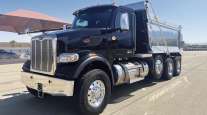Daimler to Add 1,200 Jobs at N.C. Plants in Recovery
This story appears in the Jan. 16 print edition of Transport Topics.
MIAMI BEACH, Fla. — With its Class 8 truck order book overflowing and all signs pointing to a continuing market recovery, Daimler Trucks North America said it will add a second shift to its primary U.S. production facility, creating 1,200 new jobs.
At a press briefing here last week, officials revealed that 1,100 jobs will be added at the company’s Freightliner truck production plant in Cleveland, N.C., while 100 more jobs will be created at its components and logistics facility in nearby Gastonia, N.C., as part of the Cleveland expansion.
The hiring is scheduled to begin in February, and the two plants are scheduled to be at full capacity by September.
The formal announcement was made on Jan. 12 at the Cleveland plant.
“We are incredibly pleased to be able to make this announcement today and to welcome back so many of our valued employees,” said Roger Nielsen, DTNA’s chief operating officer.
Employment at the plant shrank to about 650 from 3,500 as the recession ravaged the truck-making industry. But truck production rebounded during 2011, as sales through November jumped 57.7% over the first 11 months of 2010, reaching 150,419 units in the United States.
DTNA’s Freightliner brand is the largest-selling Class 8 truck in North America, with almost 35% of the market in the United States and Canada during 2011.
North Carolina Gov. Bev Purdue, who attended a ceremony at the Cleveland plant last week, called the development “tremendous news” for the state.
Officials said the new hiring would allow the company to double its daily production rate by October and to cut into the backlog on Cascadia orders, which now stretches up to six months.
At the Florida briefing, Mark Lampert, DTNA’s senior vice president of sales and marketing, said the company was now predicting that overall Class 8 sales would reach 253,650 in the United States, Canada and Mexico.
Total Class 8 sales for all the North American truck makers during 2011 were 201,400, he said.
Lampert said business has continued to improve and is taxing both its current production capabilities and the ability of its suppliers to keep pace.
This apparently led the company to restore the second shift in North Carolina. Freightliner also produces Class 8 trucks at two plants in Mexico and its sister brand, Western Star, at a plant in Portland, Ore.
Lampert said Freightliner’s 2011 production “was essentially sold out” by mid-May last year, which led some customers to turn to competitors and others to delay their purchases until 2012.
The company said it would be hiring 1,072 shop employees at the Cleveland plant and 29 engineers and support personnel. There are currently 1,472 employees at the factory.
Cleveland produces Class 8 trucks exclusively, including Freightliner’s Cascadia, Columbia and Argosy brands. Some 20% of its output — including all of the Argosy models, which are no longer sold in the United States — is exported to South Africa, Australia and New Zealand.
At the Gastonia support facility, DTNA said, it will hire 90 more hourly workers and 10 salaried employees in order to staff a second and third shift.
The company said it was ac-cepting online applications for the new jobs immediately. And in a sign that the national employment picture may be shifting, the company announced that it already has another 145 unfilled jobs at its various facilities around the country in various fields and urged applicants to apply at http://dtna.jobs.
Lampert said virtually all of the growth in sales has been fueled by vehicle replacement, and not by fleet growth.
Even so, he said the average age of the U.S. Class 8 fleet would likely hit a new record — “up to 6.9 years” — before the flood of new trucks begins to bring it down later in 2012.
Lampert warned that U.S. truck makers would be hard pressed to meet demand, even if the economic recovery continues at its modest pace this year.
“We shudder to think” what would happen if [gross domestic product] growth hit 3.5% and fleets began to demand new trucks to fuel fleet expansion, he said.
Lampert said the company continued to have issues acquiring enough tires, axles and fifth wheels to meet demand.
Most of the manufacturers have reported supply issues for those components. And Navistar recently said it was concerned about the supply of some foundry products, such as engine blocks and heads.
Lampert said part of the problem is that while suppliers had a reasonably good 2011, the year wasn’t strong enough to provide the additional capital for them to expand and modernize their production for the coming expansion.
As a result, he said, suppliers were pushing for more price increases, while DTNA was looking to produce more of its own components.
But, Lampert said, “We will manage our way through” and meet customer demand while working to keep prices down.




